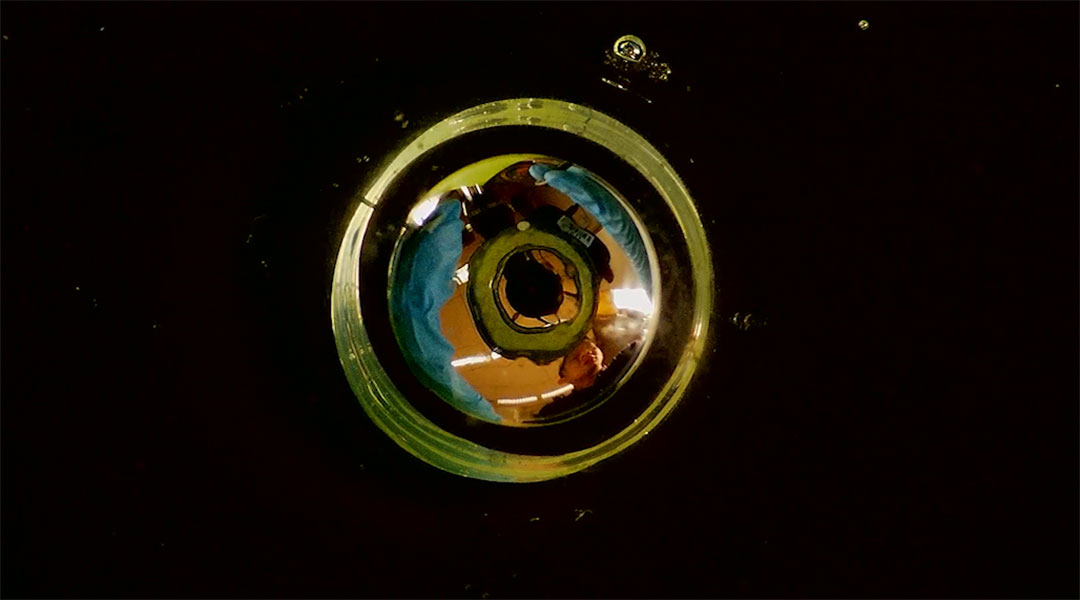As more advanced soft robotics, wearable electronics, and biomedical devices emerge, data storage systems that can be stretched, bent, and twisted to extremes without compromising their performance are fast becoming necessary.
“With the increasing use of flexible devices, there will also be a growing demand for the deformable characteristics of memory,” Jing Liu, a professor in the Department of Biomedical Engineering at Tsinghua University in Beijing, told us.
Liu and his collaborators recently developed a fully flexible resistive random access memory device — the FlexRAM — by taking an unconventional approach.
FlexRAM stores information in a solution environment, akin to the human brain, which is around 70% water. “This biomimetic approach aligns with the aqueous working environments found within living organisms, distinguishing it from conventional memory systems, [which are solid],” Liu stated.
The flexibility of memory devices has so far been limited. Normally, devices are fabricated by depositing the rigid memory components onto soft substrate materials, rendering the devices only partially flexible and leading to peeling and cracking when the device is deformed. The fabrication approach used by Liu and his colleagues could change this.
Making a memory storage device fully flexible
To fabricate FlexRAM, the researchers used an alloy composed of the elements, gallium and indium, as the memory component.
Their choice of material was also inspired by the brain, as gallium-based liquid metals undergo oxidation and reduction in a solution environment, analogous to the polarization and depolarization of neurons. Gallium-based liquid metals also maintain their liquid state at room temperature, facilitating their oxidation to form a dense gallium oxide layer on the surface of the liquid.
This oxide layer corresponds to a high electrical resistance state of the storage system, while the reduced form of the liquid, elemental gallium, is the low-resistance state. A large resistance difference between these two states — a high resistance ratio — is essential to memory storage performance.
Memory storage devices must also meet a host of other performance criteria, including high storage density, fast read and write speeds, energy efficiency, durability, reliability, and data retention. But striking a balance among these criteria while maximizing a device’s flexibility is no easy feat.
To construct a device that can withstand any extent of deformation, the researchers used Ecoflex, a stretchable polymer, as the device’s encapsulation material. Using a 3D printer, they printed Ecoflex molds and injected droplets of the gallium-based liquid metal and a solution of polyvinyl acetate hydrogel separately into cavities in the mold. The hydrogel not only helps prevent solution leakage but also enhances the mechanical properties of the device and increases the device’s resistance ratio.
According to Liu, the size of the liquid metal droplet also matters. “The size of the gallium-based liquid metal significantly influences the high-resistance state/low-resistance state ratio in the FlexRAM, with a smaller droplet size leading to an increased ratio due to enhanced surface oxide film impact,” he explained.
“Reducing the droplet size benefits the integration and scalability of the FlexRAM, making fully flexible, high-density memory a promising option for diverse engineering developments,” he added.
How the FlexRAM stores, reads, and writes data
The device encodes data through the oxidation and reduction processes of the gallium-based liquid metal. When a low voltage is applied, the liquid metal is oxidized, which corresponds to the high-resistance state of “1”. When the voltage polarity is reversed, the metal returns to its initial low-resistance state of “0”. This reversible switching process is what allows memory to be stored and erased.
The researchers demonstrated the reading and writing capability of the FlexRAM by integrating it into a software and hardware setup. Through computer commands, they wrote a string of letters and numbers, encoded in the form of 0s and 1s, onto an array of eight FlexRAM storage units corresponding to 1 byte of data information.
The digital signal from the computer was converted into an analog signal using a technique called pulse-width modulation to carefully control the oxidation and reduction of the liquid metal. “During information reading, a brief one-volt test voltage is applied to measure the system’s resistance state without altering the liquid metal’s redox state,” Liu said.
The read current is then transmitted to the computer, which uses an algorithm to convert the current signal into digital signals of 0 or 1, finally displaying the encoded message on an LED screen.
The data stored in the FlexRAM also persists when the power is switched off. In a low or no- oxygen environment, the FlexRAM can retain its data for up to 43,200 seconds (12 hours). It can also be used repeatedly, maintaining a stable performance for over 3500 cycles of operation.
This performance is promising for a prototype, but before commercialization, it needs to be improved on several fronts. According to Liu, at the moment, its response time and level of integration fall short of commercial standards. Its production process, which currently involves sequentially filling functional materials, also needs to be improved.
“In the near future, intelligent and automated manufacturing processes, coupled with three-dimensional airborne printing and packaging technology, will be employed,” Liu shared.
Reference: Jing Liu et al., Liquid Metal Memory, Advanced Materials (2023). DOI: 10.1002/adma.202309182

















